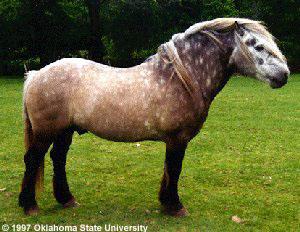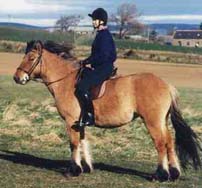

Highland


Introduction: All that I know of the Highland Pony is what I have read about it. If you have any comments or suggestions, please click here.
Names: Highland, Highland Pony. One source said locally and erroneously called Garrons; I don't know why it said "erroneously," but I will look into it later. (Since the more sources I look at, the more frequently I find this pony called the Garron, the more I think I do need to look into it; but as I have not had time, it will remain simply the Highland pony, and I won't accuse anyone if they call it the Garron!)
Origin: Great
Britain, Scottish Highlands. (Highland Pony Society.) Ancient
indigenous breed of pony, which from time immemorial has been used for
deer-stalking in the mountains. A smaller type is known as the Western
Islands pony. (One source indicated that there are actually three
types of Highland pony, but since the next paragraph says they have been merged
and I don't know anything about them, I will consider it as one for now.)
Three types, or sizes, of Scottish Highland ponies exist
today. The smallest ponies are from the island of Barra and other islands
(the Outer Hebrides) lying off the western coast; they stand from 50 to 54
inches. The second type is a riding pony of 53-57 inches; and the largest
and strongest ponies are those of the Central Highlands, called "Mainland,"
standing 56-60 inches. Obviously the latter are small horses.
Colors are dun, grey, black, or brown; sometimes bay or chestnut. Mane and
tail are usually silver. A dark mid-dorsal stripe is often, though not
invariably, present. These Highland ponies are believed to have had an
infusion of Arab blood.
Breeding: The different types of Highland pony are now merged as one, the best known being the large mainland animals. The breed is very old, but the few remaining ponies on the island of Rhum represent the most ancient strain. There has been some crossing with mainland stock, but the majority of Rhum ponies are still small and sturdy, mostly colored dun or chestnut, many with pale manes and tails.
Description: The strongest and largest of the true ponies.
Action: Extremely surefooted; can gallop and jump, but renowned as a weight-carrier.
Body: Powerful back; often rather straight, short shoulders. Strong hindquarters with short, sloping croup and low set tail. Possesses a great deal of bone.
Color: Usually gray or dun; can be black or chestnut. Bay, brown, dun or grey.
Hair: Thick mane and tail. Long winter coat.
Head: Very fine and noble.
Legs: Powerful, solid forearm.
Size: Up to 14.2 hands. 13.2 to 14.2 hands.
Temperament: Intelligent and easily taught. Tranquil character.
Features: They have the ability to "scramble up over stones, never making a false step." Hardy and as tough as their natural habitat. Industrious and has plenty of stamina. Ideal pack pony with great carrying power and indefatigable constitution.
Uses: Once used as a pack pony. Popular for driving and riding. They are indispensable to crofters, popular for trekking, and still cart stags, during the deer hunting season, over peat hags that defeat even Land-Rovers. The best and favourite pony used for shooting in the Highlands.
Accomplishments:
Curiosities: Queen Victoria loved these ponies she rode around the Scottish hillsides.
Profiles:
Conclusion: The Highland Pony is one of the "old-fashioned" breeds that hasn't changed much over the centuries. It still epitomizes the shaggy, native British pony. It is my hope that it will stay that way.